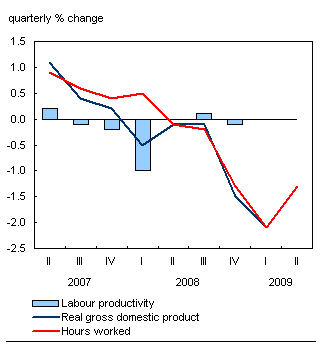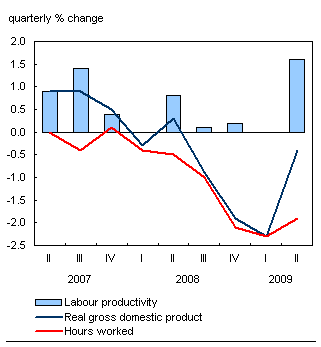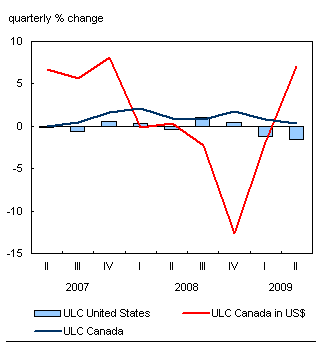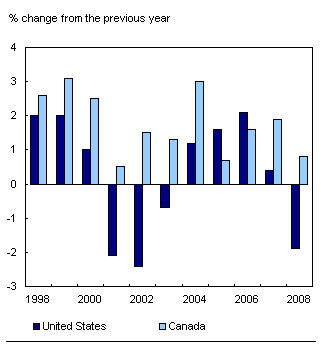Common menu bar links
Labour productivity, hourly compensation and unit labour cost
Archived Content
Information identified as archived is provided for reference, research or recordkeeping purposes. It is not subject to the Government of Canada Web Standards and has not been altered or updated since it was archived. Please "contact us" to request a format other than those available.
Second quarter 2009
Labour productivity, hourly compensation and unit labour cost note to readers
Labour productivity, hourly compensation and unit labour cost
The labour productivity of Canadian businesses did not change in the second quarter, marking the fifth consecutive quarter with little variation. Unit labour cost increased 0.3% in the second quarter, a deceleration from the increases of 0.8% in the first quarter and 1.7% in the fourth quarter of 2008.
Since the second quarter of 2008, the real gross domestic product (GDP) of Canadian businesses has changed at roughly the same pace as hours worked, resulting in little change in productivity over the last five quarters. During that period, real GDP and hours worked both declined by 4.9% cumulatively.
Output and hours worked both fell 1.3% in the second quarter of 2009, after dropping 2.1% in the first quarter of the year.
A slight upturn in domestic demand led to an increase in output and productivity in the services-producing industries, which offset a decline in the goods-producing industries.
An upswing in wholesale and retail trade and the financial industries in the second quarter boosted the service sector's productivity by 0.6%, while the goods sector posted a 0.5% decline. After falling sharply in the previous two quarters, manufacturing productivity was almost unchanged, edging down 0.1% in the second quarter.
Hours worked in the goods sector fell 3.2%, a fourth consecutive quarterly decrease. Hours worked also shrank in service industries for a fifth straight quarter, but the rate of decline was much lower than in goods. Service sector hours were down 0.5% in the second quarter, much the same pace as in the previous two quarters.
The labour productivity of American businesses rose 1.6 % in the second quarter, its largest gain in six years. In the previous three quarters, productivity followed essentially the same pattern in the United States as in Canada.
Labour costs per unit of production in Canadian dollars were up 0.3% for Canada in the second quarter, their smallest increase since the second quarter of 2007.
With little change in productivity in the last five quarters, increases in unit labour costs have essentially reflected the advance in hourly compensation.
After five consecutive quarters of depreciation, the Canadian dollar rose 6.7% in value against its US counterpart in the second quarter. That translated into a 7.0% increase in Canadian unit labour costs expressed in American dollars, the first quarterly increase since the second quarter of 2008. In comparison, unit labour costs in American businesses were down 1.5% in the second quarter, their largest drop in nine years.
Comparing labour productivity growth in Canada and the U.S.
U.S. labour productivity outpaces Canada in the second quarter of 2009
With a 1.6% jump in the second quarter, the labour productivity of American businesses recorded its largest gain in six years. In the previous three quarters, productivity followed essentially the same pattern in the United States as in Canada.
Chart F.1 The decline in hours worked again mirrors the decrease in output in Canadian businesses
Description for Chart F.1

Since the second quarter of 2008, the real gross domestic product (GDP) of Canadian businesses has changed at roughly the same pace as hours worked, resulting in little change in productivity in the last five quarters. During that period, real GDP and hours worked have both declined by 4.9% cumulatively.
South of the border, the contraction of real GDP decelerated sharply compared with the first quarter, while the pace of the downturn in hours worked remained steady, which translated into a strong gain in U.S. productivity in the second quarter.
Chart F.2 Hours worked fell much faster than output in American businesses
Description for Chart F.2

The distinct slowdown in the contraction of U.S. real GDP in the second quarter is primarily attributable to a deceleration in the decline in exports and residential and non-residential investment.
The competitiveness of Canadian businesses lost ground in the second quarter
Labour costs per unit of production in Canadian dollars - an indicator of inflationary pressure - rose 0.3% for Canadian businesses in the second quarter. That was the lowest growth rate since the second quarter of 2007.
With little change in productivity in the last five quarters, increases in unit labour costs have essentially reflected the advance in hourly compensation.
Fuelled by the 6.7% increase in the value of the Canadian dollar against its U.S. counterpart, the growth rate of Canadian unit labour costs in American dollars was 7.0% in the second quarter. In the previous five quarters, the indicator fell an average of 4.3% per quarter1, as the value of the Canadian dollar declined in every quarter during that period.
Chart F.3 Canadian unit labour costs (ULC) in American dollars rebound
Description for Chart F.3

In American businesses, unit labour costs fell 1.5% in the second quarter, the largest decrease in nine years. This reflects the substantial productivity gain in the United States, as American workers’ hourly compensation remained the same as in the first quarter.
Both countries saw the same decrease in output during the last two years, but the decline in hours was larger in the United States
Over the last eight quarters, hours worked shrank almost twice as fast in American businesses as in Canadian businesses. During that period, hours worked fell by an average of 1.1% per quarter in the United States and 0.6% in Canada.
At the same time, real GDP contracted at almost the same rate on both sides of the border: 0.7% per quarter in the United States and 0.8% in Canada.
With the recent revisions in the United States, the productivity gap remains high, despite a downward revision in 2008
For the most recent years, historical revisions in U.S. data raised labour productivity growth in the United States slightly in 2007 and reduced it by 0.8 percentage points in 2008.
Following incorporation of those revisions, average annual productivity growth in American businesses between 2004 and 2007 is now 1.5% (compared with 1.4% before the revisions), comparable to productivity growth in Canadian businesses (+1.3%).
However, for 2008, the year when the economic downturn started, there remains a wide gap in productivity growth between the two countries, despite substantial downward revisions in the United States. The annual gap in productivity growth for 2008 declined from 3.8 percentage points in favour of the United States before revision to 3.0 percentage points after the revision. The gap is mainly due to the very different trends in hours worked in the two countries during that year.
Chart F.4 In 2008, hours worked kept rising in Canada and fell sharply in the United States
Description for Chart F.4

Moreover, a substantial gap in average annual productivity growth persisted between Canada and the United States during the period from 2000 to 2004, as American productivity growth at that time was just over five times higher than Canadian productivity growth.
For the period from 2000 to 2008, average annual productivity growth is now 0.7% in Canada and 2.6% in the United States. During that period, real GDP growth was comparable on both sides of the border, but hours worked increased much faster in Canada.
Specifically, real GDP growth in Canada averaged 2.1% per year between 2000 and 2008, while the rate of increase in hours worked was 1.4%. In comparison, American real GDP grew by 2.3% on average during the same period, and hours worked declined by 0. 3%.
Historical revisions of American data for the last two decades (1981 to 2000) had virtually no impact on the gaps between Canada and the United States. The annual gap in productivity growth during that period rose from 0.3 percentage points in favour of the United States before revision to 0.4 percentage points after revision.
Notes:
1. The average quarterly growth rate for the last five quarters is calculated using five quarters of time series data, which provide four quarters of growth rates. All average growth rates in this article are calculated in this manner, such that the initial time period is included in the time series, but the growth rate of the initial period is not.Statistical tables
- Table F.1 Business sector - Labour productivity and related variables for Canada and the United States, quarterly
- Table F.2 Business sector - Some related variables for labour markets
- Table F.3 Indexes of labour productivity by industry
- Table F.4 Indexes of unit labour cost by industry
Information on methods and data quality available in the Integrated Meta Data Base: 5042.

